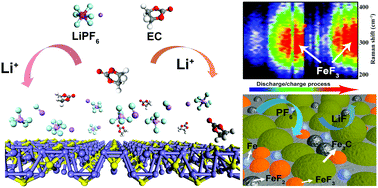Origin of extra capacity in the solid electrolyte interphase near high-capacity iron carbide anodes for Li ion batteries†
Abstract
Transition metal carbides (TMCs), known to deliver extra capacity beyond the theoretical limit, are proposed as emerging high-capacity anodes for next-generation lithium ion batteries (LIBs). Nevertheless, the underlying mechanism for the extra lithium storage in TMCs has not been revealed clearly due to the electrochemical inertness of TMCs to Li in cycling. Here, for the first time, by employing in situ Raman and X-ray photoelectron spectroscopies, we corroborate that the capacity enhancement of Fe3C anodes originates from the physiochemical evolution of solid electrolyte interphase (SEI) and surface carbonaceous materials through three mechanisms: (i) Fe3C catalyzes the reversible conversion between esters and ethers to store extra lithium ions in the SEI; (ii) Fe and inorganic components embedded in the SEI form a reversible surface-conversion reaction of Fe + 3LiF ⇌ FeF3 + 3Li+ + 3e− to contribute additional capacity; and (iii) surficial carbon delivers capacity through surface capacitive effects and Li+ inter/deintercalation processes. With the extra lithium ion storage in the SEI and carbon, the C@Fe3C/Fe anode delivers a high reversible capacity of 808 mA h g−1 after 700 cycles at 1 A g−1. This study provides a fundamental basis for emerging high-capacity TMC anodes to be efficiently explored for next-generation LIBs.

- This article is part of the themed collection: Energy & Environmental Science Cover Art


 Please wait while we load your content...
Please wait while we load your content...